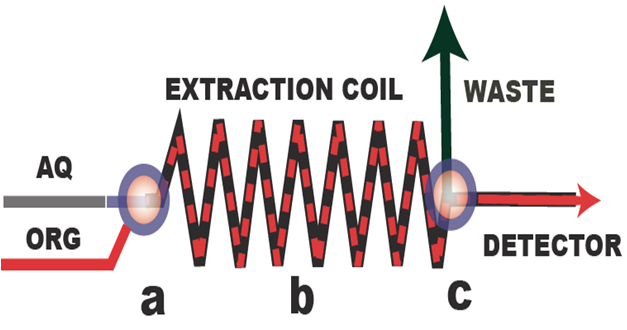Interaction between aqueous (AQ) and organic phase (ORG) with the aim of separating and accumulating a target analyte for further detection has been automated in FI (Section 1.4.12.), and SI formats (Luque de Castro 2008)
Solvent Extraction
2.3.32.

Most frequently, extraction is carried out in an extraction coil (b) made of hydrophobic tubing (PTFE) within which aqueous stream is regularly segmented by organic phase. The critical components are the segmentor (a) and (phase) separator (c), which rely on differences between hydrophophic and hydrophilic surfaces, and between densities of water and organic solvents. While segmentors and separators usually function well, phase separators tend to be the Achilles Heel of flow-based SE . Use of SI for automation of SE offers substantial reduction in the use of organic solvents, but the problem of reliable phase separation is not yet fully resolved. Therefore, alternatives such as cloud point extraction, wetting film extraction, supported liquid membrane extraction, extraction chromatography, and single-drop microextraction techniques have been proposed (for a recent thorough overview see Anthemidis and Miró 2009.)
Briefly, wetting film extraction is based on the formation of a coating on the inner walls of a PTFE extraction coil with a thin layer of organic phase over which the aqueous solution is being passed. Once the target species has been preconcentrated in the organic layer, a small plug of a suitable solvent/back-extraction solution is pumped into the coated reactor to strip out the isolated analyte, which is then delivered into the detector. The organic film is removed after each analysis cycle, so this approach is free from carryover effects. The enhanced aqueous/organic phase volume ratio in comparison with classical FI-based extraction, yields high enrichment factors.To conclude, SE in any form should be sought as the last resort, when all other separation schemes, based on sorbent extraction and /or Bead Injection fail. It is not only the toxicity of organic solvents, but the mechanics of SE automation that are troublesome.
M.D. Luque de Castro ,and B. Alvarez-Sanchez Membrane Based Separation Techniques, Liquid-Liquid Extraction
and Filtration Ch 9 in S. D .Kolev, I. McKelvie, Ed. Advances in FIA and Related Techniques Elsevier, Amsterdam 2008
A. N. Anthemidis, M. Miró Applied Spectroscopy Reviews, 44: 140–167, 2009









